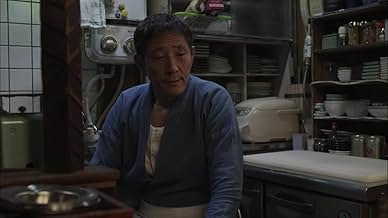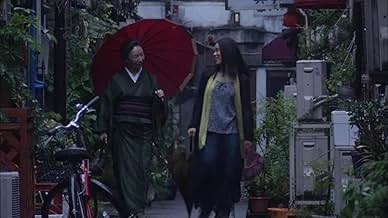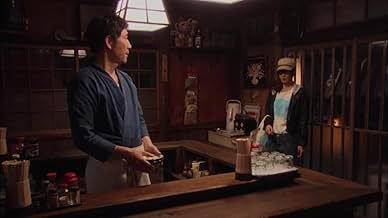IMDb RATING
8.6/10
3.5K
YOUR RATING
Set in a small restaurant open only after midnight. This drama depicts the lives of the restaurant's patrons, who come for the amusing chatter and the proprietor's willingness to cook any di... Read allSet in a small restaurant open only after midnight. This drama depicts the lives of the restaurant's patrons, who come for the amusing chatter and the proprietor's willingness to cook any dish they request.Set in a small restaurant open only after midnight. This drama depicts the lives of the restaurant's patrons, who come for the amusing chatter and the proprietor's willingness to cook any dish they request.
- Awards
- 1 win total
Browse episodes
Featured reviews
Known in Japan as "Shinya Shokudo", this series is better known as "Midnight Diner" in the US.
The series itself is about the main character "The Master" who is a chef at a diner named Midnight Diner, which is only open from midnight till 7am. The supporting cast is filled with people from all walks of life, such as: hotel workers, cab drivers, exotic dancers, etc as they all order something to eat and drink, sit down and enjoy each other's company, as well as the stories that each customer has to tell.
The opening song to the series is a simple yet elegant Japanese folk song by the artist Tunekichi Suzuki. As you listen to the music it make you feel at ease and make you wonder what is he singing about.
The song titled "Omoide" is translated to "Memories," and by the way, the lyrics go by, he must be talking about memories of his own or memories of our own as we look into the sky. This fits well with Midnight Diner as in there is always a story to be told in a place you least expected and wonder what is that story is about. If you have the time.
It is on Netflix and is worth the watch.
The series itself is about the main character "The Master" who is a chef at a diner named Midnight Diner, which is only open from midnight till 7am. The supporting cast is filled with people from all walks of life, such as: hotel workers, cab drivers, exotic dancers, etc as they all order something to eat and drink, sit down and enjoy each other's company, as well as the stories that each customer has to tell.
The opening song to the series is a simple yet elegant Japanese folk song by the artist Tunekichi Suzuki. As you listen to the music it make you feel at ease and make you wonder what is he singing about.
The song titled "Omoide" is translated to "Memories," and by the way, the lyrics go by, he must be talking about memories of his own or memories of our own as we look into the sky. This fits well with Midnight Diner as in there is always a story to be told in a place you least expected and wonder what is that story is about. If you have the time.
It is on Netflix and is worth the watch.
Ultimately, this is about important moments in our lives and the foods we often associate with them.
The stories are set at the Midnight Diner, a small and comfortable hole-in- the-wall sitdown you wish you could call your own.
Open from midnight until seven in the morning, it attracts an array of regular and casual denizens. The proprietor will make whatever is ordered, so long as he's got the ingredients.
Often what's ordered are comfort foods that remind the patron of the home of their youth, of a parent or someone close, or of a memorable or important life event. Sometimes it's all of the above.
Many of the tales are peculiar, and even if you suspect a direction the story will take, it likely won't.
Everything about the show is simple and unassuming, which of course is akin to most of our comfort foods.
This won't resemble anything you've ever seen. We laughed out loud throughout and shed several tears. Every last second of it is beautiful, thoughtful, and unexpected.
The stories are set at the Midnight Diner, a small and comfortable hole-in- the-wall sitdown you wish you could call your own.
Open from midnight until seven in the morning, it attracts an array of regular and casual denizens. The proprietor will make whatever is ordered, so long as he's got the ingredients.
Often what's ordered are comfort foods that remind the patron of the home of their youth, of a parent or someone close, or of a memorable or important life event. Sometimes it's all of the above.
Many of the tales are peculiar, and even if you suspect a direction the story will take, it likely won't.
Everything about the show is simple and unassuming, which of course is akin to most of our comfort foods.
This won't resemble anything you've ever seen. We laughed out loud throughout and shed several tears. Every last second of it is beautiful, thoughtful, and unexpected.
The show brings about a serene calm when you watch it. The delicate theme mixed with the intricately flavoured characters, makes it a bowl you just can't keep down.
Based on a comic by Yarou Abe, Shinya Shokudo is a story about a small hole in the wall late night restaurant (literally Shinya Shokudo in Japanese) that operates between midnight and 7:00 a.m. in the morning. The restaurant is run by only one person, the master (Kaoru Kobayashi) of the joint. There are only four items on the menu Tonjiru (pork based stew), beer, sake, and shochu (potato liquor), but customers can order anything the master can make in his kitchen. The restaurant is located in the Hanazono area of Shinjuku, and has only the generic description of "Meshiya" (food place in Japanese) on its lantern.
So far 20 episodes has been on air between 2009 (the first series) and 2011 (the second series). They were all broadcast in the late night slot between midnight and 2:00 in the morning. For a late night program that are considered a "hit" if they average 1% viewers, this program consistently got over 2% ratings that attests to its popularity.
The episodes consists of life stories of customers who frequent the restaurant, but starting in the second series, each episodes consists of new customer who have their own life stories going. Because of the hours the restaurant operates, and the nature of its size, customers who frequents the place have their life in specialized areas of society that includes gangs, construction workers, lady godiva, and also part timer, fast food joint owner, salaried workers, but most of them has special background that makes the story unique and interesting.
Each episodes has particular dish that master makes that relates to the story. The list of foods on each of the episodes are as follows:
Season 1:
1. Baked Sausage and tamago yaki.
2. Bonito shavings and rice
3. Rice with tea
4. Potato salad.
5. Butter rice
6. Katsu Donburi
7. Egg sandwich
8. Yaki soba
9. Broiled Aji
10. Ramen
Season 2:
1. Baked Sausage
2. Chicken Karaage
3. Steamed clam
4. Nikogori (gelatin left from cooking fish)
5. Canned foods
6. Cream Stew
7. Pickeled Bock Choi
8. Cold ramen
9. Potato cooked with beef
10. Gyoza (Pot Stickers)
The series is superb in that it tells the story of the underbellies of the society with emotion, sentiment and love unlike any other stories told. Food designer Nami Iijima designed the foods that appear in this series, and all of these items are common items consumed by Japanese families, but not usually served in ordinary Japanese restaurants.
If you can find a copy of this drama, it will be an interesting watch guaranteed.
So far 20 episodes has been on air between 2009 (the first series) and 2011 (the second series). They were all broadcast in the late night slot between midnight and 2:00 in the morning. For a late night program that are considered a "hit" if they average 1% viewers, this program consistently got over 2% ratings that attests to its popularity.
The episodes consists of life stories of customers who frequent the restaurant, but starting in the second series, each episodes consists of new customer who have their own life stories going. Because of the hours the restaurant operates, and the nature of its size, customers who frequents the place have their life in specialized areas of society that includes gangs, construction workers, lady godiva, and also part timer, fast food joint owner, salaried workers, but most of them has special background that makes the story unique and interesting.
Each episodes has particular dish that master makes that relates to the story. The list of foods on each of the episodes are as follows:
Season 1:
1. Baked Sausage and tamago yaki.
2. Bonito shavings and rice
3. Rice with tea
4. Potato salad.
5. Butter rice
6. Katsu Donburi
7. Egg sandwich
8. Yaki soba
9. Broiled Aji
10. Ramen
Season 2:
1. Baked Sausage
2. Chicken Karaage
3. Steamed clam
4. Nikogori (gelatin left from cooking fish)
5. Canned foods
6. Cream Stew
7. Pickeled Bock Choi
8. Cold ramen
9. Potato cooked with beef
10. Gyoza (Pot Stickers)
The series is superb in that it tells the story of the underbellies of the society with emotion, sentiment and love unlike any other stories told. Food designer Nami Iijima designed the foods that appear in this series, and all of these items are common items consumed by Japanese families, but not usually served in ordinary Japanese restaurants.
If you can find a copy of this drama, it will be an interesting watch guaranteed.
8mcdt
Beware, there are two shows on Netflix with a similar name. They are basically the same, but presented separately. Midnight Diner: Tokyo Stories, has two seasons from 2016 and 2019, and was commissioned by Netflix, but the original three Midnight Diner seasons ran from 2009 to 2014. I didn't know the difference at first, and couldn't understand why Netflix couldn't remember which episode I last watched, and why the characters use old cellphones in one episode and then a more advanced one in the next! Anyway, regardless of which series you watch, these slow-moving episodes are delightful as you get familiar with the culture, food, eating habits and regular customers of the restaurant dubbed the Midnight Diner, which, as the title suggests, opens at midnight. The owner, known as "Master", is willing to prepare any dish, as long as he has the ingredients. There is a short cooking summary at the end, so stay tuned until the credits. There are recurrent characters in both shows, but each episode can also be a stand-alone. The episodes are short and low-key, so you can watch it to unwind after a hectic day.
Did you know
- TriviaBased on manga series "Shinya Shokudo" by Yaro Abe (first published October, 2006 in Japanese seinen manga magazine Big Comic Original).
- ConnectionsRemade as Shimyashikdang (2015)
Details
- Runtime24 minutes
- Color
- Aspect ratio
- 1.78 : 1
Contribute to this page
Suggest an edit or add missing content























